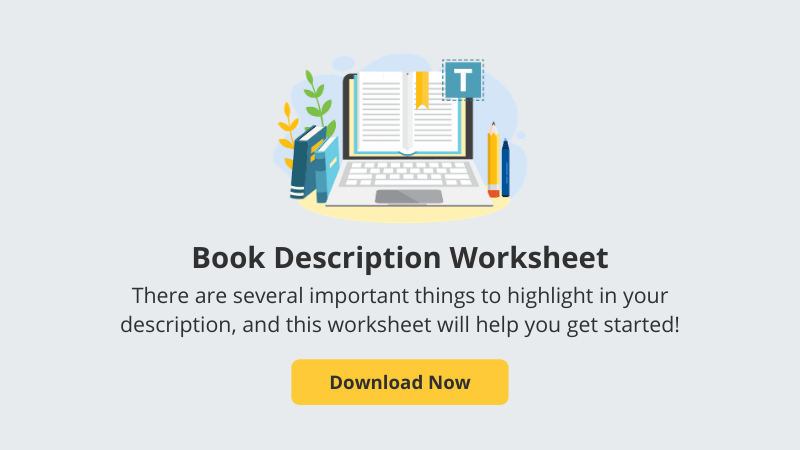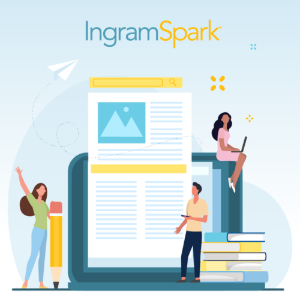Want to instantly capture readers? No matter who you are or what genre your book falls into—nothing beats getting engrossed in a book description that leaves a reader wanting more. Short and long book descriptions both serve a purpose—to make you and your book look good. Before you start writing, here are a few things you need to know.
Understanding Book Metadata
There are several things to consider in order to help your book achieve its greatest potential discoverability. Readers, librarians, and retailers can't purchase a book they can't find, and your book metadata is responsible for whether or not your book pops up when they type in search terms relevant to your book. Book metadata may sound complicated, but it consists of all the information that describes your book, including: your title, subtitle, series name, price, trim size, author name, book description, and more. There are two metadata fields for your book description: the long book description and the short book description. Although both play a role in driving traffic to your book, they have distinct differences.
Take IngramSpark's FREE Online Self-Publishing Course on Optimizing Book Metadata
Whether reading the short or long description, both need to be full of what readers want: intrigue. It’s up to you to get readers interested in what you have to say, and while we know you could probably write pages upon pages explaining what your book is about, your space and reader attention span is limited. When creating book metadata, you want to make sure you provide the information needed to help buyers, including consumers, booksellers, and librarians, understand what they're about to purchase and whether they want to. Having the right information in place determines not only whether you attract the attention of your audience, but whether you attract the right audience.
Writing a good book description isn't just about telling readers what your book's about once they find it; it's about telling search engines what search queries your book could answer so that they actually can find it.
The Purpose of a Good Book Description
You enter your book description when you set up your title and provide your basic book information, called book metadata. You're able to set your book's metadata when you own the ISBN associated with your book, which is one of the many reasons it's important to own your own ISBN. A good book description is a detailed, descriptive copy that is good for public display, used for your book marketing, book discovery, and for sales purposes. It helps potential buyers find and understand your book. It's your pitch. Your chance to get people interested. And it's your opportunity to get search engines interested as well. The better your book description, the better your chances of gaining visibility and remaining visible.
Self-publishing is on the rise! Discover how to write and publish a book like a pro with IngramSpark.
 Tips on How to Write a Good Book Description
Tips on How to Write a Good Book Description
- Describe your book in simple, straightforward, and consumer-friendly terms.
- Your description should be at least 150-200 words long.
- Give readers enough information to understand what your book is, what it’s about, and if they’ll like it—key factors in deciding whether to buy your book.
- Consider a prospective online customer who hasn’t read the book, can’t physically pick it up, and may not know anything about it yet. If they don’t know the book exists, how would they look for something like it? What words would they type into a search engine?
- Use paragraph breaks, bold and italic fonts, and other structural elements like ordered lists (bullet points) to provide emphasis and highlight key aspects of your book. Short paragraphs and bulleted lists are better than a single block of text.
- HTML markup, the tags used to tell web pages how to display your text, should be limited to: <p>, <br />, <ul>, <ol>, <li>, <em> or <i>, <strong> or <b>, and corresponding end tags. Ensure that any code is clean and valid. Do not include active hyperlinks in your description.
- Avoid time-sensitive language, so that your description does not become outdated. For example, do not say “latest,” “soon,” “forthcoming,” or “most recent,” and do not refer to “last year” or an author’s “next book.”
- To get ideas for good descriptive copy, read the top consumer reviews for some titles comparative to yours. Great reader reviews often are very effective at explaining books in an enticing and engaging way.
The Structure of a Good Long Book Description
Your long book description is a synopsis. When writing this description, think like a buyer, and not like the author. You must become a master at both show and tell. Show enough to paint the picture, and tell enough to get them interested in what happens next. Any specific highlights should immediately jump off the page.
 If you had to write your author bio in 200 to 300 words, what would you say about yourself? How detailed would you be? If you're hoping to build a connection with the person reading your bio, you'd most likely reveal the best or most interesting aspects about yourself. You wouldn't tell them every minute detail; you'd tell them enough to let them know whether they wanted to get to know you better. Your book description should do the same.
If you had to write your author bio in 200 to 300 words, what would you say about yourself? How detailed would you be? If you're hoping to build a connection with the person reading your bio, you'd most likely reveal the best or most interesting aspects about yourself. You wouldn't tell them every minute detail; you'd tell them enough to let them know whether they wanted to get to know you better. Your book description should do the same.
Headline
Start with a clear and punchy headline that highlights the big things that matter about your book from a reader perspective (genre, key topics and themes, major brands, awards). Get them to want to find out more or simply purchase based on what they’ve read already.
- The headline should be a maximum of 200 characters (roughly 25-30 words). This is what will be seen on retailer pages before consumers are prompted to “read more,” so make sure it can stand alone and is grabbing. The headline should sell your book in a few words.
- Make it bold and follow it with a paragraph break.
- It should have a strong selling focus. Think of this as the “elevator pitch”—less about the plot and the specific details and more about why a busy reader should want this book. If someone didn’t know the book existed, what might they be looking for that would bring them to your book? (Something like, “A beautifully illustrated picture book about bullying, friendship, and learning to stand up for what’s right” beats “Sam and Sally don’t get along.”)
Detailed Exposition
The headline should be followed by a detailed exposition. If a consumer clicks to “read more,” you want them to find rich detail about the book. This is the meat of your description. Give them a taste of the writing they can expect from you while revealing what your book is about.
- 100+ words detailing the notable topics, themes, plot elements, and features of your book
- For fiction titles, this is where you can describe the plot, settings, and key characters.
- For non-fiction, detail the subjects covered and important people, places, and things.
- This is where you can “set the mood” and give readers an idea of the style and tone of your book
- Use paragraph breaks and bulleted lists where appropriate to add structure and break up large blocks of text.
Strong Close
Finally, the copy should end with a strong close, emphasizing the value someone stands to gain from buying your book. If someone has read this far, they are interested. Now make the sale with a memorable final pitch.
- At least 25-50 words.
- Who is the book for? “Fans of …”, “Great gift for…”
- Consider including awards and nominations or a strong review quote.

What’s a Short Book Description?
The short description is exactly that—short and sweet. Consider it a blurb, elevator pitch, or hook. It tells enough about your book to keep readers interested, and delivers enough punch to have them searching for the long book description to read more.
Publishers use this short book description to showcase and sell. It appears in publishing catalogs, trade show copy, online websites, marketing materials, press releases, and more. It's your book's calling card for the world to see. Informative, engaging and thought-provoking. That’s the reaction you want each time someone reads it.
Although the long and short book descriptions stand alone, they play off each other to provide rich content for your potential buyers. Both are used for marketing purposes, public information, and to drive sales. Before writing either of these pieces, do your research. What are the keywords that your potential buyers search for? Make sure you write your book descriptions using words your ideal consumer would be searching for so that you can attract the right attention more efficiently. Look at other long and short descriptions to determine whether or not you find them engaging and get tips from the ones you do. The first step is getting discovered, and the second is keeping them engrossed in what you've written. Remember to stay age-appropriate, be relatable, and highlight any awards you may have won to enhance your selling points. Everything else will fall into place.
Strong book metadata is necessary for your book's success. How to write a good book description is just one piece.
Are you ready to publish your own book but unsure of where to start? Discover how to write and publish a book like a pro with IngramSpark.













